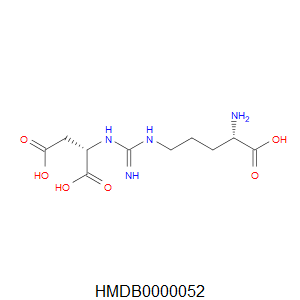| General Information of MET (ID: META01429) |
| Name |
Arginosuccinic acid
|
| Synonyms |
Click to Show/Hide Synonyms of This Metabolite
2-(Nomega-L-arginino)succinate; L-Argininosuccinate; L-Argininosuccinic acid; L-Arginosuccinic acid; 2-(Nomega-L-arginino)succinic acid; L-Arginosuccinate; Argininosuccinate; 2-(N(Omega)-L-arginine)succinate; 2-(N(Omega)-L-arginine)succinic acid; 2-(N(Omega)-L-arginino)succinate; 2-(N(Omega)-L-arginino)succinic acid; 2-(Nw-l-arginino)butanedioate; 2-(Nw-l-arginino)butanedioic acid; Arginosuccinate; Arginosuccinic acid; ASA; N(Omega)-(L-arginino)succinate; N(Omega)-(L-arginino)succinic acid; N-(((4-Amino-4-carboxybutyl)amino)iminomethyl)-L-aspartate; N-(((4-Amino-4-carboxybutyl)amino)iminomethyl)-L-aspartic acid; N-(L-Arginino) succinate; N-(L-Arginino) succinic acid; N-(L-Arginino)succinate; N-(L-Arginino)succinic acid; N-[(4-Amino-4-carboxybutyl)amidino]-L-aspartate; N-[(4-Amino-4-carboxybutyl)amidino]-L-aspartic acid; N-[[(4-Amino-4-carboxybutyl)amino]iminomethyl]-L-aspartate; N-[[(4-Amino-4-carboxybutyl)amino]iminomethyl]-L-aspartic acid; Acid, argininosuccinic; N-(4-Amino-4-carboxybutyl)amidino-L-aspartic acid; Prostate gland; Kidneys; Cytoplasma
|
| Source |
Aliphatic acyclic compounds
|
| Structure Type |
Amino acids, peptides, and analogues (Click to Show/Hide the Complete Structure Type Hierarchy)
Organic acids and derivatives
Carboxylic acids and derivatives
Amino acids, peptides, and analogues
|
| PubChem CID |
|
| HMDB ID |
|
| Formula |
C10H18N4O6
|
| Structure |
<iframe style="width: 300px; height: 300px;" frameborder="0" src="https://embed.molview.org/v1/?mode=balls&cid=16950"></iframe>
|
 |
|
3D MOL is unavailable
|
2D MOL
|
|
Click to Show/Hide the Molecular/Functional Data (External Links/Property/Function) of This Metabolite
|
| KEGG ID |
|
| ChEBI ID |
|
| FooDB ID |
|
| ChemSpider ID |
|
| METLIN ID |
|
| Physicochemical Properties |
Molecular Weight |
290.27 |
Topological Polar Surface Area |
188 |
| XlogP |
-4.7 |
Complexity |
397 |
| Heavy Atom Count |
20 |
Rotatable Bond Count |
10 |
| Hydrogen Bond Donor Count |
6 |
Hydrogen Bond Acceptor Count |
8 |
| Function |
Arginosuccinic acid is a basic amino acid. Some cells synthesize it from citrulline, aspartic acid and use it as a precursor for arginine in the urea cycle or Citrulline-NO cycle. The enzyme that catalyzes the reaction is argininosuccinate synthetase. Argininosuccinic acid is a precursor to fumarate in the citric acid cycle via argininosuccinate lyase. Defects in the argininosuccinate lyase enzyme can lead to argininosuccinate lyase deficiency, which is an inborn error of metabolism. Argininosuccinate (ASA) lyase deficiency results in defective cleavage of ASA. This leads to an accumulation of ASA in cells and an excessive excretion of ASA in urine (argininosuccinic aciduria). In virtually all respects, this disorder shares the characteristics of other urea cycle defects. The most important characteristic of ASA lyase deficiency is its propensity to cause hyperammonemia in affected individuals. ASA in affected individuals is excreted by the kidney at a rate practically equivalent to the glomerular filtration rate (GFR). Whether ASA itself causes a degree of toxicity due to hepatocellular accumulation is unknown; such an effect could help explain hyperammonemia development in affected individuals. Regardless, the name of the disease is derived from the rapid clearance of ASA in urine, although elevated levels of ASA can be found in plasma. ASA lyase deficiency is associated with high mortality and morbidity rates. Symptoms of ASA lyase deficiency include anorexia, irritability rapid breathing, lethargy and vomiting. Extreme symptoms include coma and cerebral edema.
|
|
Regulatory Network
|
|
|
|
|
|
|
|
|
 click to show the details of this protein
click to show the details of this protein
 click to show the details of experiment for validating this pair
click to show the details of experiment for validating this pair

